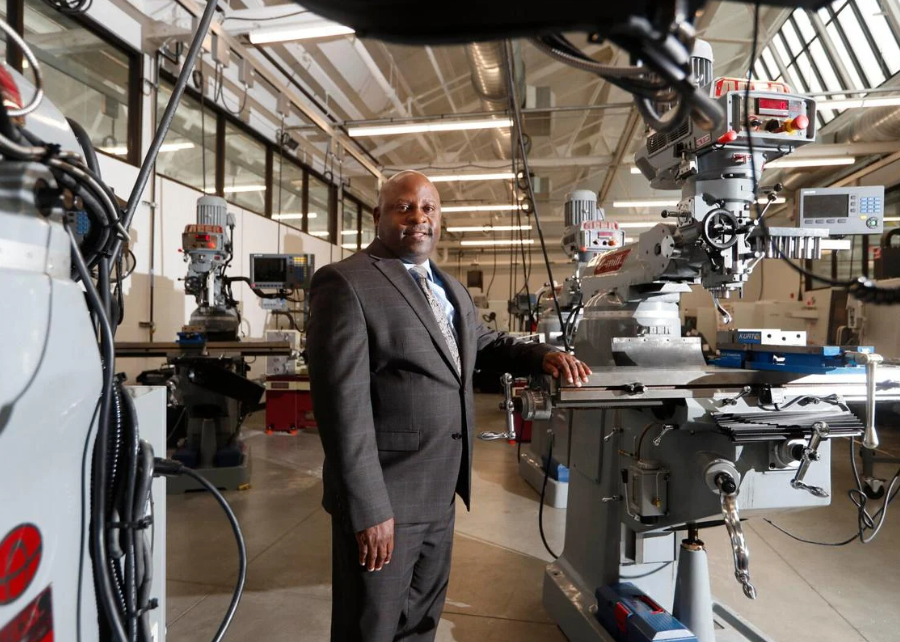Tucker said the workforce training center has worked with several companies’ front-line managers, training them how to lead front-line workers of color. Companies can also provide private spaces for workers’ religious practices and for nursing mothers, he said.

Manufacturers Focusing on Workforce Needs, Energy Rules
02.02.23
Manufacturers focusing on workforce needs, energy rules
Story originally published in February 2023 via The Buffalo News
By Matt Glynn
Photos via The Buffalo News
Manufacturers in the Buffalo Niagara region have a lot on their minds, beyond supply chain issues and inflation.
They’re trying to fill job openings and get young people interested in manufacturing careers. They’re preparing for state requirements for powering their facilities in the long run. And they’re absorbing higher costs for unemployment insurance.
Here’s what they are saying about those topics:
Hiring needs
Manufacturers are struggling to fill job openings to keep up with their production needs. Stephen Tucker, CEO of the Northland Workforce Training Center, said that hiring needs to create greater workforce diversity. Only 20% of people in production jobs are people of color, and just 5% are women, he said.
“We have to be able to find a way to connect with that pool of candidates, and not only attract those individuals – get them prepared for the jobs, employ these individuals – but create welcoming workplace culture where they’re going to feel valued and advance in their careers, and retained within those jobs,” Tucker said at a manufacturing forum hosted by the Buffalo Niagara Partnership.
“If you don’t have the inclusive environment, that is not going to retain folks,” Leteste said. “And then if that is the first experience those individuals have in the manufacturing industry, then that’s even worse word of mouth for the next individuals you’re trying to bring in.”
Image obstacles
Manufacturers have to overcome outdated perceptions of their careers and worksites, and hosting visits by students is one way to create new impressions, Tucker said. The Northland center is trying to spread the word that its training programs lead to jobs, he said. Eighty seven percent of its graduates have been placed in jobs with partner employers, and many of those graduates received multiple jobs offers. They earn average starting salaries of $40,000, and, more importantly, embark on a career path to earn more, he said.
Tucker said it is important to get the message across to not only prospective students, but their parents, as well. Along with perception issues, employers are coping with a tight labor pool amid a low labor force participation rate, Tucker said. “You’re not only competing against other manufacturers, you’re also competing against other industries,” he said.
While employers are scrambling to fill jobs for CNC machine operators, enrollment in that program at the Northland training center is lagging. Only about 30 students are enrolled in it, compared to the 80 to 100 enrolled in each of its programs for mechanical engineering, mechatronics and welding, Tucker said.
Energy emphasis
The state is preparing to make sweeping changes to how homes and businesses are powered over the next several years. The changes will start with newly built homes, in 2025, and then, in subsequent years, expand to include equipment replaced in existing homes and commercial buildings. It’s part of a push to combat climate change that favors electrification over fossil fuels like natural gas and propane.
Critics have said the plan doesn’t explain how the state will meet the need for dramatically more electricity. Proponents say the goals can be met, and that the state is overdue in moving away from fossil fuels, in the interest of public health.
The Partnership has estimated that it might cost a factory three times as much to run on electricity as on natural gas. Veronica urged manufacturers to speak up about their concerns.
Now that bill has come due, and business groups such as the Partnership are criticizing the state for sticking employers with the remaining tab of about $8 billion, in the form of an interest assessment surcharge. The Partnership has urged the state to apply some of its federal Covid-19 relief funds to pay down the debt. So far, that hasn’t happened.
Electrifying news
About a year ago, General Motors announced a blockbuster investment in its Lockport components plant. GM committed to investing $154 million in the facility to make stator modules, which are key components in electric motors. Where do things stand with the project?
GM has purchased equipment and will start installing it at the Lockport facility later this year, said Sarah McDonough, a GM spokeswoman.
The automaker has hired a small group of hourly and salaried employees to manage the project, and will start filling additional roles, including production-line jobs, closer to the start of production. Production is expected to launch in the first half of next year.
The investment is a boost for the Lockport plant, aligning its future with GM’s. The automaker has committed to selling an all-electric car and truck fleet by 2035.
GM has previously said the $154 million investment would add 230 jobs at the Lockport plant by 2026. As of late September, the plant had 1,586 employees, making the site one of the region’s largest manufacturing employers.


